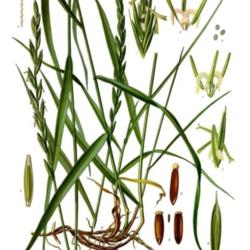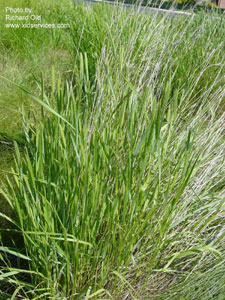
Quackgrass (Agropyron repens) is a persistent perennial weed in the northern half of North America. Plants usually appear in broad, 1- to 3-foot-tall clumps, because new shoots grow from wandering underground rhizomes. To avoid spreading root pieces, do not cultivate soil where quackgrass is present. Instead, carefully dig plants from beneath, and gather up all the root pieces you can. Between digging sessions, brush patches with an organic herbicide containing acetic acid. Crowd seedlings and root-borne sprouts with dense plantings. Mulch to reduce seed germination. Mow mature plants to reduce reseeding.
Weed Control TechniquesDigging. Weeds that regrow from persistent roots must be dug. Use a spade or digging fork to dig spreading perennials, such as bindweed, Canada thistle, and quackgrass. Start digging a foot away from the plant's center to loosen the soil. Then lift the weed from beneath, which reduces how many root pieces are likely to break off and regrow. Dandelion, dock, and other weeds that grow from persistent taproots can be dug the same way, or you can use a special fork-like tool called a dandelion weeder to pry them up. Dig very large taproots that are difficult to pry loose. In lawns and other places where digging dandelions is not practical, use a sharp knife to slice off the leaves and the top inch or two of taproot at a diagonal angle. Some weeds that are easily pulled when the soil is moist must be dug from dry soil.

Organic herbicides. There are several herbicides made from natural ingredients. Those that contain clove oil (eugenol) give the best control of young broadleaf weeds. Products containing acetic acid, often in combination with citric acid, do a good job on young grasses. Some products contain both clove oil and acetic acid, so they are useful for a broad variety of weeds. Soap-based herbicides dehydrate leaves by cutting through their protective layer of cutin. All of these types of organic herbicides work best on young weeds and pose only a temporary setback to well-rooted perennial weeds. To minimize damage to neighboring plants, spray only in dry, still weather. To maximize effectiveness, spray young weeds when temperatures are above 70 degrees F and the sun is shining brightly. Be aware that repeated applications of a product containing acetic acid (which is very strong vinegar) can lower the soil's pH, making it more acidic.
Crowding plants. When plants grow so close together that the ground between them is shaded, sun-seeking weeds, such as pigweed and purslane, don't have a chance. Use double rows rather than single ones whenever possible in your vegetable garden. In flower beds, place flowers in closely spaced groups. As plants need more room to grow, thin them gradually so weeds get only a fleeting chance at good light. Plants with broad leaves, such as squash and cabbage, do a good job of crowding out weeds. Vigorous lawn grasses that form a tight turf naturally crowd out weeds. To keep turf tight, apply a slow-release organic fertilizer during your lawn's most active season of new growth. The recommended cutting height varies with different species of grass, but with any type of grass it's a good weed-preventive strategy to mow high and often. Long blades of grass often do a good job of shading out germinating weed seeds.
Mulching. Mulch that's more than 2 inches thick can deprive most weed seeds of the light they need to germinate and grow. In vegetable and flower gardens, you can mulch with wheat straw (which has fewer weed seeds than hay), chopped leaves, grass clippings, or many other organic materials. Where weeds are numerous, try covering the soil with four to six sheets of newspaper. Then cover the newspapers with 2 to 3 inches of organic mulch. Pieces of scrap carpeting make a good weed-suppressing mulch to use in pathways between rows. When mulching beneath shrubs and trees, place a sheet of landscape fabric over the soil, then cover it with 3 inches of organic mulch. An edging (a 4- to 6-inch-wide strip of rot-proof material driven into the ground vertically) of brick, stone, or metal will help the mulch stay put, halt invasion by creeping weeds, and make the bed look neat and well groomed.
Reducing reseeding. Most weeds reproduce primarily from seeds, and the seeds of some weeds can remain viable when buried in the soil for decades. So it's essential to keep weeds from shedding seeds in the garden. Garden weeds that are neglected until they reach seed-bearing age can be lopped off near the soil line with pruning shears, a stout knife, or a string trimmer with a blade attachment. Cutting back perennial weeds again and again not only reduces reseeding, it also forces the plants to use up food reserves stored in their roots. In a garden that has gone hopelessly weedy, mowing it down promptly, raking out the seed-bearing debris, and starting over next year is a big step in the right direction. Mowing regularly helps keep weeds under control in lawns. When mowing lawns where seed-bearing weeds are present, collect the clippings in a bagger and dispose of them in a shady place.
Image courtesy of Randall G. Prostak, University of Massachusetts
 |
 |
 |
 |
 |
 |
 |
 |